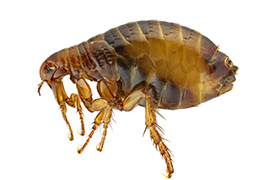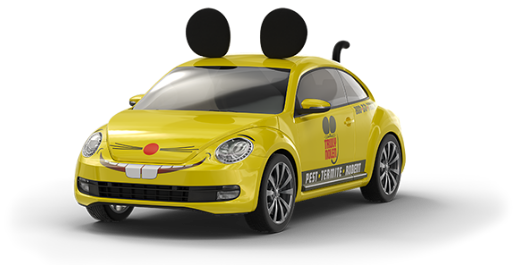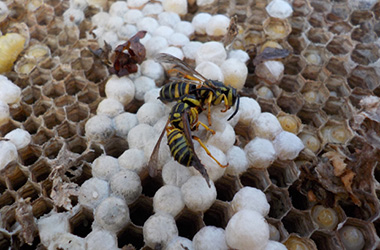
- Scientific name: Ctenocephalides canis
- Size: Fleas range in size from 0.15 to 0.31 cm.
- Appearance: Flat, wingless and dark colored
Fleas in the workplace?
It doesn’t need to be a pet store, kennel, or veterinarian’s office to have a flea problem. Fleas can be introduced into the office by a domesticated dog or cat coming in with an employee or customer. The animal doesn’t need to stay, even a brief visit can bring fleas into the business.
There are more than 2,000 species of fleas, but the most common is the cat flea. It feeds on mammals, including dogs, cats, and humans. Unlike most other flea species, the adult cat flea stays on its host and can take up to twenty blood meals each day. This flea is a potential vector of diseases, such as the plague, Murine typhus, tularemia and dog tapeworm.
When a flea bites a human, a small red spot with a single puncture point develops. Generally, the flea takes its blood meal around the ankles of its human host. Bites may itch, but swelling is unusual. Keep in mind that ants and spiders leave two puncture marks and the bite of a mosquito or sting of a bee generally results in some swelling at the site.
Inspection
Begins with a customer interview, followed by a thorough visual inspection for pest IDENTIFICATION and DETERMINATION of a course of action.
Fleas are attracted to the color white. Once you’ve identified the “hot zone,” place a piece of white paper on the floor and wait a few minutes. Fleas will generally collect on the paper. They look like small black dots. Now, you’ve confirmed their presence!
It’s critical for the pest professional to interview the customer. Frequently, what generates the call for help is an employee and/or the business’s clients complaining about insect bites. The pest professional asks to the customer about the presence of pets in his business, whether routine or occasional. He conducts a visual inspection of the area(s) where employees report getting bit and/or where pets are or were present. Any surface is susceptible to infestation, including carpeting, upholstery, offices, waiting areas, etc.
The pest professional makes thorough notes of all findings and always invites the customer to participate in the inspection process. He then develops a graph and site plan that outlines his findings.
The pest professional discusses with the customer which areas require preparation before treatment.
Customer Prep
- Just prior to treatment, the customer should thoroughly vacuum all areas where fleas were identified, with particular attention to any place that an animal rested or where animal bedding is situated. Once done, the vacuum bag should be sealed in a plastic bag and immediately discarded in an outside trash receptacle.
- The customer should wash and dry any animal bedding at the hottest temperature it will tolerate or discard it in an outside trash receptacle if washing is not feasible.
- Debris and/or litter around the structure, especially up against the building, are common flea hiding places and should be removed, if possible.
- If the animal is on site, it is recommended that a veterinarian treat the animal(s) for fleas on the day that Truly Nolen provides flea service. This should prevent the animal(s) from re-introducing the pest into the treated environment, as well as remove the insect for the benefit of the animal’s health.
Action Plan
- Preparation
- To avoid contamination, the technician verifies that any pet feeding dishes and other animal related items are removed from the target treatment area.
- To ensure the safety of customer’s staff, clients and animals, please keep them out of treated area(s) until materials are dry (approximately one hour) and ventilate the interior during that time.
An adult flea is a small reddish-brown bug that is laterally compressed. This means that the bug is not very wide in order for it to move more easily between the hairs of animals. Fleas also have small spines on their body’s that prevent them from being brushed off of the host. Additionally, a flea has a hard, outer body that prevents it from being smashed. Because of these adaptations, it can be difficult to kill them.
Fleas are parasites that feed off of blood, both human and animal, by piercing the skin from the outside and sucking blood. Because they do not have wings, fleas travel from hosts by hopping. They can hop up to18 cm in the air.
Fleas are a pest that many pet owners have had to deal with at some point in time. Because many species of fleas prefer to feed off of animals, pets are the most common method for fleas to infest a household. Although fleas prefer animals, once inside a home they will often bite and feed off of humans as well.
- How to Get Rid of Them
- Infestation
- Bites and Treatment
4 Seasons Pest Control

Satisfaction Guarantee
What it includes*
-
Ants
-
Crickets
-
Fleas
-
Mice
-
All Roaches
-
Scorpions
-
Spiders
-
Ticks
-
Wasps
-
Other*



